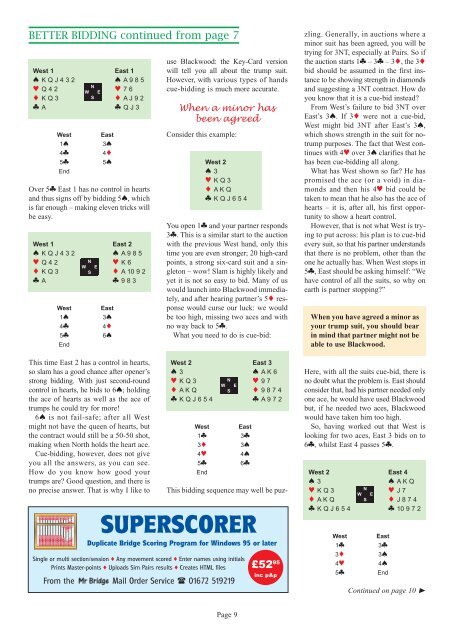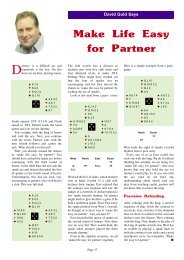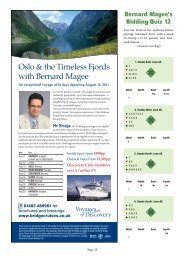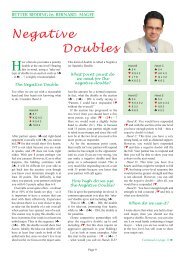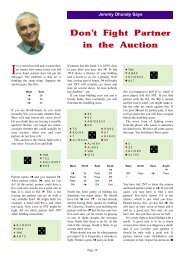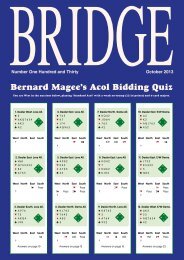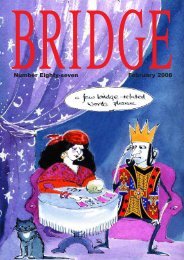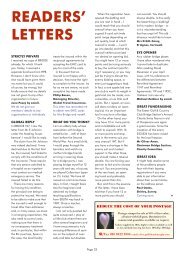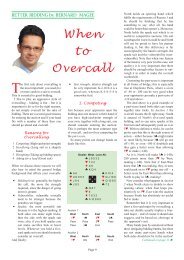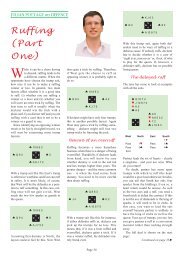Create successful ePaper yourself
Turn your PDF publications into a flip-book with our unique Google optimized e-Paper software.
BETTER BIDDING continued from page 7<br />
West 1 East 1<br />
♠ K Q J 4 3 2 ♠ A 9 8 5<br />
N<br />
♥ Q 4 2 ♥ 7 6<br />
W E<br />
♦ K Q 3 S ♦ A J 9 2<br />
♣ A ♣ Q J 3<br />
West<br />
1♠<br />
4♣<br />
5♣<br />
End<br />
East<br />
3♠<br />
4♦<br />
5♠<br />
Over 5♣ East 1 has no control in hearts<br />
and thus signs off by bidding 5♠, which<br />
is far enough – making eleven tricks will<br />
be easy.<br />
West 1 East 2<br />
♠ K Q J 4 3 2 ♠ A 9 8 5<br />
♥ Q 4 2 N ♥ K 6<br />
W E<br />
♦ K Q 3 S ♦ A 10 9 2<br />
♣ A ♣ 9 8 3<br />
West<br />
1♠<br />
4♣<br />
5♣<br />
End<br />
East<br />
3♠<br />
4♦<br />
6♠<br />
This time East 2 has a control in hearts,<br />
so slam has a good chance after opener’s<br />
strong bidding. With just second-round<br />
control in hearts, he bids to 6♠; holding<br />
the ace of hearts as well as the ace of<br />
trumps he could try for more!<br />
6♠ is not fail-safe; after all West<br />
might not have the queen of hearts, but<br />
the contract would still be a 50-50 shot,<br />
making when North holds the heart ace.<br />
Cue-bidding, however, does not give<br />
you all the answers, as you can see.<br />
How do you know how good your<br />
trumps are? Good question, and there is<br />
no precise answer. That is why I like to<br />
use Blackwood: the Key-Card version<br />
will tell you all about the trump suit.<br />
However, with various types of hands<br />
cue-bidding is much more accurate.<br />
When a minor has<br />
been agreed<br />
Consider this example:<br />
West 2<br />
♠ 3<br />
♥ K Q 3<br />
♦ AK Q<br />
♣ K Q J 6 5 4<br />
You open 1♣ and your partner responds<br />
3♣. This is a similar start to the auction<br />
with the previous West hand, only this<br />
time you are even stronger; 20 high-card<br />
points, a strong six-card suit and a singleton<br />
– wow! <strong>Slam</strong> is highly likely and<br />
yet it is not so easy to bid. Many of us<br />
would launch into Blackwood immediately,<br />
and after hearing partner’s 5♦ response<br />
would curse our luck: we would<br />
be too high, missing two aces and with<br />
no way back to 5♣.<br />
What you need to do is cue-bid:<br />
West 2 East 3<br />
♠ 3 ♠ AK 6<br />
♥ K Q 3 N ♥ 9 7<br />
W E<br />
♦ AK Q S ♦ 9 8 7 4<br />
♣ K Q J 6 5 4 ♣ A 9 7 2<br />
West<br />
1♣<br />
3♦<br />
4♥<br />
5♣<br />
End<br />
East<br />
3♣<br />
3♠<br />
4♠<br />
6♣<br />
SUPERSCORER<br />
Duplicate <strong>Bridge</strong> Scoring Program for Windows 95 or later<br />
Single or multi section/session ♦ Any movement scored ♦ Enter names using initials<br />
Prints Master-points ♦ Uploads Sim Pairs results ♦ Creates HTML files<br />
From the Mail Order Service 01672 519219<br />
£52 95<br />
inc p&p<br />
This bidding sequence may well be puzzling.<br />
Generally, in auctions where a<br />
minor suit has been agreed, you will be<br />
trying for 3NT, especially at Pairs. So if<br />
the auction starts 1♣ – 3♣ – 3♦, the 3♦<br />
bid should be assumed in the first instance<br />
to be showing strength in diamonds<br />
and suggesting a 3NT contract. How do<br />
you know that it is a cue-bid instead?<br />
From West’s failure to bid 3NT over<br />
East’s 3♠. If 3♦ were not a cue-bid,<br />
West might bid 3NT after East’s 3♠,<br />
which shows strength in the suit for notrump<br />
purposes. The fact that West continues<br />
with 4♥ over 3♠ clarifies that he<br />
has been cue-bidding all along.<br />
What has West shown so far? He has<br />
promised the ace (or a void) in diamonds<br />
and then his 4♥ bid could be<br />
taken to mean that he also has the ace of<br />
hearts – it is, after all, his first opportunity<br />
to show a heart control.<br />
However, that is not what West is trying<br />
to put across: his plan is to cue-bid<br />
every suit, so that his partner understands<br />
that there is no problem, other than the<br />
one he actually has. When West stops in<br />
5♣, East should be asking himself: “We<br />
have control of all the suits, so why on<br />
earth is partner stopping?”<br />
When you have agreed a minor as<br />
your trump suit, you should bear<br />
in mind that partner might not be<br />
able to use Blackwood.<br />
Here, with all the suits cue-bid, there is<br />
no doubt what the problem is. East should<br />
consider that, had his partner needed only<br />
one ace, he would have used Blackwood<br />
but, if he needed two aces, Blackwood<br />
would have taken him too high.<br />
So, having worked out that West is<br />
looking for two aces, East 3 bids on to<br />
6♣, whilst East 4 passes 5♣.<br />
West 2 East 4<br />
♠ 3<br />
♠ AK Q<br />
N<br />
♥ K Q 3 ♥ J 7<br />
W E<br />
♦ AK Q S ♦ J 8 7 4<br />
♣ K Q J 6 5 4 ♣ 10 9 7 2<br />
West<br />
1♣<br />
3♦<br />
4♥<br />
5♣<br />
East<br />
3♣<br />
3♠<br />
4♠<br />
End<br />
Continued on page 10 ❿<br />
Page 9


